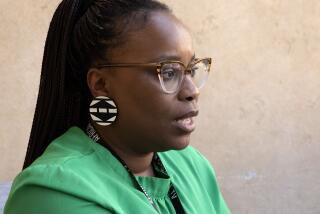Putting money where the gender diversity is: How international film boards are pushing the cause of female filmmakers
- Share via
In March 2015, an Australian researcher published a statistic that drew both laughs and gasps in the business community there: Fewer large Australian companies were run by women than by men named Peter.
The damning statistic prompted some introspection in the Australian film industry in particular, where women represent 17% of directors, a number that hasn’t budged since 1970.
“We’ve got this wonderful networking psyche here called ‘mateship,’ ” said Fiona Cameron, chief executive of Screen Australia, the nation’s government-funded film board. “It typically involves men helping like-minded men. There’s been an informal quota in the Australian film business forever. That made our filmmakers stop in their tracks and say, ‘What are we going to do?’ ”
In December, Screen Australia committed $5 million to changing the number, setting a goal that its money would go to films with creative teams at least 50% female.
Australia is one of several countries that have launched such programs in recent years -- Canada, Ireland and Sweden have also started aggressive, state-financed initiatives aimed at increasing the number of female directors, writers and producers on their films.
The programs stand in stark contrast to the American film industry, where a controversy is roiling over the same issue, but where there is no comparable government agency that finances movies. Here in Hollywood, change is mostly taking a different path, with the U.S. Equal Employment Opportunity Commission launching an investigation into gender bias in the hiring of female directors last fall.
In the U.S., women are even less likely to be in the director’s chair than they are abroad -- women direct just 4% of the 100 top-grossing Hollywood movies, according to a USC study, making filmmakers like Elizabeth Banks (who directed “Pitch Perfect 2,”) Sam Taylor-Johnson (“Fifty Shades of Grey”) and Ava DuVernay (“Selma”) the very definition of outliers.
At the urging of the American Civil Liberties Union, the EEOC began interviewing female directors in October, and is now meeting with executives, agents and others to determine whether a pattern of bias exists.
Internationally, the film industry is in the midst of a kind of feminist awakening, with the inciting incident being slightly different in each country.
In Ireland, a protest in the theater world last fall kicked off the discussion, when a planned centenary celebration of the 1916 Easter Uprising at the country’s national theater included just one female playwright, and nine men.
“We went, ‘Hang on a minute, we’re just as bad,’ ” said Annie Doona, chair of the Irish Film Board, where 20% of the movies financed between 2010 and 2015 had female directors. “We need to know what’s happening here.”
In December, the agency set a target of achieving 50/50 funding within three years, as part of a larger program that also includes mentorship, training and film school initiatives.
“We’ve said to production companies, ‘We’re looking to you to find that female talent,’ ” Doona said.
In Canada, the National Film Board announced a similar program in March -- going forward, the agency will devote 50% of its $65-million annual budget to projects directed by women.
“We’re funded equally by Canadians who are men and Canadians who are women,” said board President Claude Joli-Coeur. “The talent of women directors is there. We just decided to make it so.”
Many countries are looking to Sweden as an example. When Anna Serner, an outspoken chief executive from the advertising world, became head of the Swedish Film Institute in 2011, 26% of the movies the agency financed were directed by women. Due in large part to Serner’s aggressive advocacy, by 2014, 50% of the films the institute financed were directed by women. Female directors now win about 60% of the prizes at Sweden’s version of the Oscars, and the majority of Swedish directors invited to international film festivals are women.
Sweden’s programs, which are partly funded by a 10% tax on movie tickets, would seem unthinkably interventionist in the market-driven American film industry, and have even been controversial in a country that considers gender equality a cornerstone of its identity.
“Some male directors have been very upset,” Serner said. “They still get 50% of our financing, but they feel we’re manipulating the arts. People say they want equality, as long as it doesn’t affect them.”
Each of these new foreign programs will have an effect on the number of women employed in film overall, but many of the movies, and even the film boards, have far smaller budgets than the major studio productions that dominate the American industry.
“Finance is the area where we see the largest impediment facing females, so any system that can facilitate women getting access to capital is promising,” said Stacy Smith, director of the Media, Diversity & Social Change Initiative at USC’s Annenberg School. “But where is the lever and the pressure on the multinationals?”
In the U.S., the closest parallel to the state-financed film programs abroad is probably a bill currently in committee in the New York Legislature that calls for allocating $5 million of the state’s $420-million tax rebates for the salaries of female and minority writers and directors. The bill has bipartisan support, and has been endorsed by high-profile Hollywood writers including Tina Fey, Tom McCarthy and Michael Arndt.
And given that those state-by-state tax rebates factor greatly in the Hollywood decision-making process, that is real leverage state governments have to incentivise change.
As the gender equity debate wends its way through U.S. agencies and institutions, Serner said she is increasingly meeting female American producers, executives and agents frustrated by the pace of change. She described a conversation she had last fall with a high-ranking female production executive from a major studio at the Toronto International Film Festival.
“She was a bit desperate,” Serner said. “She kept bringing up examples of women directors she tried to get hired and couldn’t. She said to me, ‘I’m really trying.’ But she was also afraid of losing her job for being too outspoken.”
MORE:
It’s illegal to discriminate ‘because of sex.’ But what does that actually mean?
Welcome to the mad circus of the Cannes market
Feminism, Spielberg and a German showstopper: Times staffers make sense of Cannes
More to Read
Only good movies
Get the Indie Focus newsletter, Mark Olsen's weekly guide to the world of cinema.
You may occasionally receive promotional content from the Los Angeles Times.











